Iran, the magnificent Ancient Persa!
- fabio pellizzato
- Jan 20, 2024
- 14 min read
Updated: Dec 17, 2024
A journey from North to South touching the cities of Tehran, Kashan, Isfahan, Yazd, Shiraz, and Bandar Abbas with the island of Qeshm. On the way back the city of Tabriz and the magnificent rocky village of Kandovan. Activities included visits to the desert, a night at the caravanserai, Persepolis, Unesco heritage gardens, and much more!
☛ ITINERARY IN MAP TIPS TEHERAN KASHAN ESFAHAN YAZD SHIRAZ BANDAR ABBAS E QESHM TABRIZ AND KANDOVAN SPECIAL

Before departure
Flight and Visa
Before leaving, it is necessary to obtain a visa to travel to Iran. To get it, we relied on vistionline.it but you can also go to the Embassy in Rome or the Consulate in Milan. You need the itinerary, the round-trip flight booked and at least the first hotel booked. It must be requested 3 months before the trip and arrives in 3 weeks.
We flew from Istanbul with Turkish Airlines, which has good service and fares and the flight time is only 3 hours.
The journey begins!
Teheran in the family
Iran is huge and we chose to travel by moving between the different main destinations from the north to the south of the country by bus, train, and flight. Before we left, we downloaded the Snapp app where you can find taxis at very low prices. It's worth using this when you arrive in Tehran because for less than 5 Euros you can get to the center and you don't have to wait for hours for the metro. At the airport, we got a sim card for just 5 euros from Irancell which was enough for the whole 3-week trip; while at the bank they had a few bills to change.
In Tehran, we had decided to be hosted by a family we met on coachsurfing to discover the customs of these mysterious people. We knew that Iranians are famous for their kindness and hospitality and in fact, the experience turned out to be unique..Amir and Parya had taken the day off to stay with us. They took us to the new Iran Mall, where some rooms of the royal palace have been reconstructed with magnificent mirrors and inlays, traditional-style cafes, a huge library, Dubai-style hanging gardens, and many excellent shops and restaurants. Everywhere, large portraits of Imam Khomeini and Ali Khamenei watch over and admonish the people.
After lunch, the heat began to feel and they preferred to avoid the walk around the artificial lake outside the mall to avoid dizziness. The afternoon passed between the city's impressive traffic and chatting...they asked us all kinds of questions - 'Do you like Ferrari or Lamborghini, Belluci or Julia Roberts more?' - and were curious about how life is in Italy and Europe.
Thanks to them we had our first opinions on their situation: they have photos of their parents in costume and they don't understand how they got to today's bans, they don't feel that revolution and they feel suppressed by a system that doesn't represent them; Fortunately, the protests that so frightened European tourists have served and now women can wear the hijab down or a bonnet (although in reality this only happens in the big cities of Tehran, Esfahan, and Tabriz). A small curiosity, in the house they had both a toilet and a Turkish, and Iranians always prefer Turkish, indeed many think that the toilet is unhygienic and carries diseases. In the evening we saw the view from the top of the city, the Azadi Tower, and the illuminated Milad Tower then we tested the typical cuisine with the best pizza in Tehran - with ketchup, thyme, and kebab meat, strange but good - and the traditional ice cream, a real treat made with ice noodles, lemon syrup, and cream ice cream.
We had hoped to also see the historical center of the capital, but we had to leave the next day. However, we returned there towards the end of the trip and were able to see from the outside: the Royal Golestan Palace, Grand Bazaar, street food street Babhomayoon str to Khomeini Square (recommended!), and the former American Embassy, symbol of the revolution.
🏨 Tehran is the most expensive city for hotels and it is not easy to find a free room. Hostels should be avoided, while the Amir Hotel (60 euros with breakfast) was excellent in terms of service and quality.
Kashan and Kavir Desert
We arrived in Kashan by train: it felt like going back in time Orient Express-style, not because the train was old, but because of the unexpected service inside. At the station, there are separate luggage checks for men and women and you have to get your passport signed by the police to pass through the document check before the platforms; there are a few trains with very tight schedules to allow for the checks. On the train, there are a maximum of a dozen carriages with 4-seater bunks and a person in charge of each carriage who brings tea, biscuits, and other foodstuffs and takes care of getting the passengers to their destination.
Kashan is a typical oasis city with winding streets and walls of red earth and thatch, it is a dry heat and refreshments with fresh drinking water can be found everywhere. We visited the
Fin Gardens, a Unesco heritage site, is one of the oldest and most beautiful Persian gardens with fountains, frescoed palaces, and the source of the river that supplies the city;
Tabatabei Historical House (at least one traditional house is a must and they are well preserved only in this city with underground wind chambers that created and still create natural air conditioning);
Agha Bozorg Mosque which lights up red at night and where people gather for evening prayer;
Grand Bazaar, with the ancient Aminoddole caravanserai inside where you can still find typical workshops with carpet weavers using ancient wooden looms...here in Iran the ancient crafts have remained and it's sad to think how much our culture is now made up of technological machinery, standardization, and Chinese products.
With an excursion proposed by our hotel (practically a taxi driver) we went to explore the subterranean city Noushabad -evitable if not to understand how water was stored - and the nearby ruins of the ancient fort, the imposing Mohammed Helal Shrine with green and blue majolica and mirrors, our real goal the Maranjab Desert and the salt lake where we saw the sunset and many camels happily grazing approaching curiously.
In the desert there is also a caravanserai where you can sleep at night and watch the stars, it is in the middle of nowhere except for a few trucks transporting salt.
🏨 Sana Historical Hostel & Hotel
🍴Falafel/Bandari, the best chickpea falafel sandwich near Agha Bozorg
Esfahan the city of wonders of ancient Persia
Esfahan, or also Isfahan, is the city that steals the hearts of all tourists for its awe-inspiring historic buildings from the Safavid period, romantic bridges along the river, and large, tree-lined boulevards reminiscent of those in Europe.
Naqsh-e Jahan Square is the main square, overlooked by the Aali Qapu Palace with its enormous terrace of inlaid wood and ancient frescoes from which the Shah once watched the polo matches played where there is now a fountain, the Shah's Mosque, the jewel of Iran, marvelous in its blue colors and very high minarets, the Sheik Lotfollah Mosque that was reserved only for the Shah family with a secret passage from the Aali Qapu Palace;
Branching off from the main square is the Grand Bazaar where you can find true gems of local handicrafts such as carpets, paintings on camel bones, inlaid wooden boxes, jewelry, utensils, and fresh pistachio nuts. The merchants invite you to enter the shops but do not insist on making you buy, they want to chat, explain their work and spend time with the tourists who are becoming increasingly scarce... they even offered us lunch because it had been months since they had seen an Italian.
Jame'a Mosque is beautiful because it is quiet and hidden among the bazaar streets.
Towards evening, one must go to the river to walk in the greenery, see the famous picnics, and admire the illuminated bridges: Allahverdi Khan Bridge, Chubi, Khajoo. The latter is the most famous and peculiar, in the evening Iranians meet here to sing songs under its arches.
The Armenian Quarter creates a break from the rest of the city, here there seems to be more wealth and you can see some typical houses and visit the Vank Cathedral with its vivid frescoes of Christian martyrs and the Armenian Genocide Museum.
🏨 Esfahan Traditional Hotel 4 stars excellent with traditional style rooms and an inner garden with wooden sofas and carpets to enjoy the evening coolness.
🍴 before the Khaju bridge, near Pol Pizza, there is a fast food restaurant that makes stratospheric kebabs.

Yazd: city of Zarathushtra, Towers of Silence, night at Caravanserai
Yazd is a little gem in the desert, a well-kept oasis town with traditional buildings and a central street for strolling after dark.
The old city center is enclosed in small winding streets where you will find the Jameh Mosque with shops next to it including the one where they sell the best traditional coffee in the city, Clock Tower, Alexander the Great's prison (although the locals don't believe it's a true story), the bazaar and a little further from the center the Amir Chakhmaq Complex. In the summer months, one can watch the Nakhl-Gardani, a ritual in which a large decorated wooden structure is carried.
The city is most famous for Zarathushtra and the Zoroastrian religion. Here one can visit the Fire Temple where the sacred flame is constantly burning and where there is information about the lifestyle and ceremonies of this community. It was the most widespread religion in Iran between the 6th and 10th centuries B.C. until the spread of the Islamic religion; it spread to many countries in Asia and today the Indian Parsis are only the largest representative group.
Just outside the city, it is possible to visit the two Towers of Silence where funeral rites took place until around 1970: the corpse was first washed in the rooms at the foot of the towers, then taken to the top of the tower to be left to rot and be devoured by vultures and other birds. Once only the bones remained, they were dissolved in the center with acid. There were two towers to take over every six months and have them purified by fire. Zoroastrians believed that corpses were impure and could contaminate the soil, water, air, and fire sacred to them. The vultures, on the other hand, were perfect for the task because they have always fed on carcasses; supposedly, the consumption of medicines in the 20th century by humans helped the reduction of these animals, because they transmitted with the carcasses, compromising the vulture's digestive system.
We went to see the Cham Tower Of Silence, just outside the city where there are no tourists and you are free to walk around everywhere...it makes quite an impression to walk where so many bodies have been eaten.
Outside Yazd, you can visit the beautiful Pahlavanpur Garden and you can have the unique experience of drinking water from a Qanat: kilometers of underground excavations under the desert that have been carrying water from the mountain to the city for millennia; you can recognize them on the surface because they form small mounds lined up along the desert. A few kilometers away is the Saryazd Castle, very impressive with its tunnels and earthen lanes where thousands of people were protected in ancient times; the 6,000-year-old stone gate of Farar left under the ravages of time; the Robat-e-kohen Caravanserai where you can sleep for 15 euros or stop for a meal.
We preferred a historic caravanserai dating back to the 1500s, 40 kilometers from Yazd - the Zein-o-din Caravanserai - where the caravans with camels laden with goods from the Silk Road used to stop. It has the original circular shape, with beautiful rooms, good food, the chance to see the sunset and the stars, and two loving and interesting owners who explain to us the sacrifices to open this historic place, the difficulties of today with the lack of tourists and the pain for the animals that are killed in this area that should be a nature reserve (leopards stretched by trucks and gazelles chased by motocross bikes to give them heart attacks). They informed us that there is also a reserve of Iranian zebras nearby but we didn't have time to go and see them.
🏨 Yazd Friendly Hotel in the historic center of Yazd, spartan but with everything you need for only 15 euros per room.
🏨 Zein-o-din Caravanserai for an unforgivable night.
🍴 Fooka with higher prices, good food, and a terrace overlooking the mosque.
Shiraz
Shiraz is one of Iran's top tourist destinations for Persepolis, the stained glass mosque, and for being the home of the Shiraz wine we like so much. Getting here is not easy and you have to put in 6-8 hours by bus.
Among the most beautiful things to visit:
Nasir Ol Mosque, the pink mosque for its majolica flowers and the most photographed mosque in Iran for the play of light from the stained glass windows during the early morning (8 am to 10 am).
Valik Bazar is the most beautiful bazaar in Iran for its fabrics, turquoise, and handicrafts with a mosque inside and ancient Turkish baths to visit.
Shah Cheragh Shrine erected for the two sons of the seventh Shia Imam Musa Al-Kadhim, is one of the most important places for the Iranian religion and the site of two ISIS attacks in late 2022 and August 2023 (the only mosque with security checks and a dedicated free guide). Its interior is enchanting with inlaid mirrors and incredible woodwork...the guide explains that the mirror inlay master who did the wall decorations when he was young is now said to be unable to do them again...and unfortunately, this ancient art is being lost because young people no longer cultivate the ancient crafts.
Tomb of the poet Hafez, a place much loved by Iranian tourists and of great peace where one can relax in the beautiful gardens or buy a copy of poems with various translations.
A full day should be dedicated to Persepolis and nearby sites. You can call a driver on Snapp and arrange to be dropped off for the whole day for 15-20 euros.
Persepolis, the ceremonial capital that was to display the immense grandeur of the Persian Empire of Darius I and Xerxes I.
It was one of the five capitals together with Babylon, Ecbatana, Pasargade, and Susa. It was founded in 500 B.C. by Darius and developed by Xerxes, but its construction was never finished because of the siege by Alexander the Great. and destruction by his soldiers.
Why ceremonial? Here, once a year during the spring equinox, representatives and emissaries of the tributary countries were welcomed with solemn processions in honor of Ahura Mazda, the divine creator and symbolic figure of Zoroastrianism. It is easy to imagine these processions ascending the monumental double staircase to reach the 12-meter-high platform on which the city stood. They passed under the Gate of Nations guarded by two Lamassu (Assyrian protective figures with bull bodies, human faces, and wings) and approached the Apadana, a large 72-column courtyard near the Throne Room and the Treasury. Here one can admire the bas-reliefs depicting the 23 provinces or satrapies - Medes, Alamites, Egyptians, Armenians, Babylonians, Assyrians, Ethiopians, Joni, Scythians, Lydians, Thracians, Indians, Arabs - as they bring gifts and tribute to the King of Kings.
A few kilometres away is Naqsh-e Rostam: an impressive place with several tombs, including those of Darius I and Xerxes, which open like secret crevices in the high rock walls.
While 50 km to the north is Pasargade: here in a large desolate heath lies the tomb of Cyrus the Great and the capital he had built, of which almost nothing remains today. It is said that Alexander the Great paid homage to this mausoleum and was impressed by the inscription carved on the tomb.

Finally, outside Shiraz, one can visit Pink or Maharloo Lake which is tinged with pink, the national park, and the mountains where nomads live, trekking and sleeping in their camps.
🏨 Tata Traditional Hotel in the historic center, very spartan but in a good location.
🍴 Kateh Mas restaurant (delicious and very nice in a traditional style), Soofi restaurant, and Doosi Restaurant (which means at grandma's and they do traditional dishes with a creative flair and very good drinks). All three recommended by Iranians, were beautiful and we ate very well.
"Go to the deep South ..but are you sure? It's so hot!" ..and in fact, you can't survive outside the house 😅
Bandar Abbas and the island of Qeshm on Persian Sea
This part of Iran should only be visited when it is winter season here in Italy, otherwise leave it alone. The degrees seem almost normal (around 38-40) but the humidity is at unimaginable levels and you get dehydrated with just five minutes in the open air, night and day indifferently.
In Bandar Abbas, we were hit by a hellish, sultry heat that we were not prepared for.
The city has everything you would expect from a seaside tourist destination, but only in the winter months, because in August everything is suffocated by a heavy dome of rarefied hot air.
After an eight-hour night bus ride (an experience we do not recommend as you can't sleep a wink), we go to the port to catch the ferry to Qeshm Island. The cost is about 10 euros and it takes about an hour. Taxi to the villa by the sea was booked, but nobody opened the door and we were left in the sun and heat for half an hour..when they finally opened the door they apologized a thousand times and offered us lunch and dinner for that day and all the days to come.
The plan was to visit the length and breadth of both Qeshm and Hormuz - the hippest one; instead we only managed to see:
Persian Sea, very warm water with large turtles swimming ashore. Men, boys, and girls bathed in swimming costumes, while women, all covered, rarely jumped into the water;
Center of Qeshm with the waterfront, the old fortress, and the bazaar;
Star Valley: a geological formation unique in Iran and rare in the world with stone stalagmites sticking out of the ground creating an incredible landscape.
Otherwise, as soon as we set foot outside the house we sweated so much that we were dry and full of bubbles in less than a quarter of an hour. After three evenings spent watching Iranian TV made up mostly of religious speeches, we left for the north on an internal flight (they are cheap at around 30 Euros and even give snacks).
Return to the cool of the North
Tabriz and the Coloured Mountains
Tabriz is a city close to Turkey and you can feel this influence so much in the contours of the city and in the behavior of the people who seem to feel freer here than in other parts of the country. At first glance, it seems poorly maintained and poor compared to other cities, but it hides a magnificent Grand Bazaar: the largest in Iran and the one that gives the most satisfaction for the food on display, thanks also to the area's mild and cool climate that makes agriculture flourish. Here you can find spices and dried fruit at very low prices, but also silver and beautiful carpets. It was precisely from Tabriz that the trade and export of Persian carpets, which have become so famous throughout Europe, began in ancient times.
Outside Tabriz is another incredible and rare natural site in the world: the Colored Mountains. Only in Iran, China, and Peru can they be seen and they are a sight not to be missed. High rocky and sandy mountains of cream color with red, brown, pink, and green streaks. To get there, just take a Snapp taxi or ask at the hotel and for 10 euros you can see two spots where you can hike and take pictures. Unfortunately, they are located along a busy road, but they convey their beauty all the same.
🏨 Hotel Morvarid, spartan but an excellent location for getting around the city.
🍴 Restaurant: we ate in a very local restaurant (only us as tourists!), the typical dish: a kind of large °flat bread° with roast potatoes, and spices. Unfortunately, we do not remember the name of that restaurant.
Kandovan: the village carved into the rock
Last stop outside Tabriz: Kandovan. We get there with a taxi driver chosen on Snapp who picks us up the next day and would love to invite us to dinner at his place, but unfortunately, we have a flight.
Kandovan was the Capadocia before tourism arrived. Apart from the main hotel where we also stayed, everything else has remained intact. Here, the 600 or so inhabitants still live in troglodyte houses carved into the lava rock which look like so many pointed hoods; the houses consist of small, cramped rooms on several levels of rock, where they also sleep and receive tourists hoping to earn some money. Nearby are stables where mules or sheep are kept. The inhabitants mostly engage in traditional activities such as shepherding, beekeeping, carpet weaving, and metalworking.
At the foot of the village flows a small river, on either side of which are stalls and a spring of drinking water. Iranians come to Kandovan to take a trip out and to have their beloved picnics in the dedicated air that offers a beautiful view. It only takes a few hours to visit the village, we chose to spend a night there to see it lit up with evening lights and we enjoyed the magical atmosphere...
🏨 Hotel Kandovan Rocky Village is very nice and at a cheap price.
Useful tips:
Where to stay: best to choose hotels with European facilities, without too many expectations
Transport: SNAPP app
Food: tasty dishes at first but as there is zero variety you get bored quickly. The malt-flavoured drinks are not bad
Itinerary in the map:
Iranians are the kindest and most hospitable people you will ever meet in your life!
Go and visit it before a compromised political situation closes the borders!
Have a nice trip!







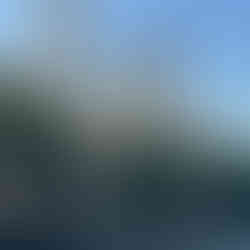






























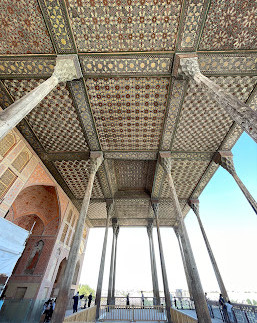









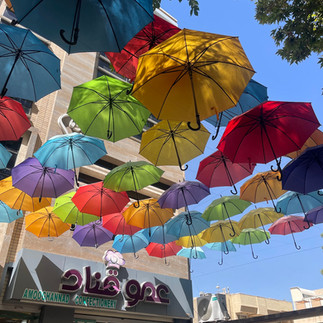

















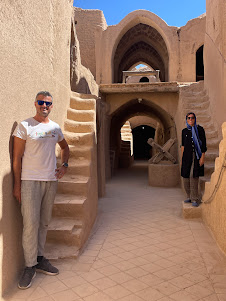












































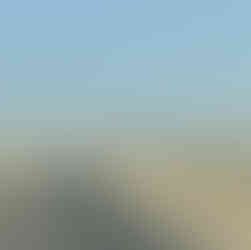






















































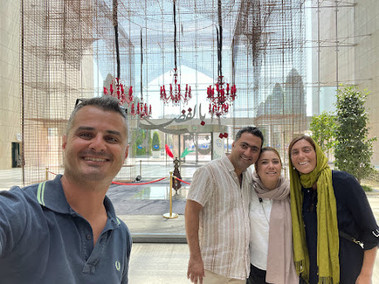









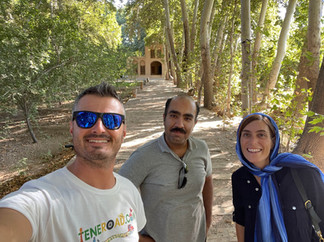













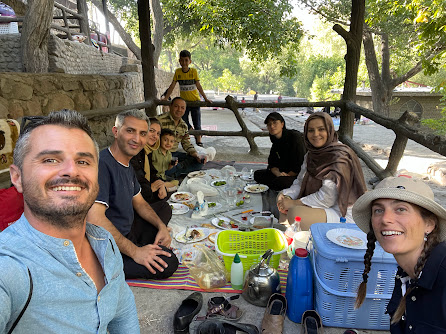






Comments